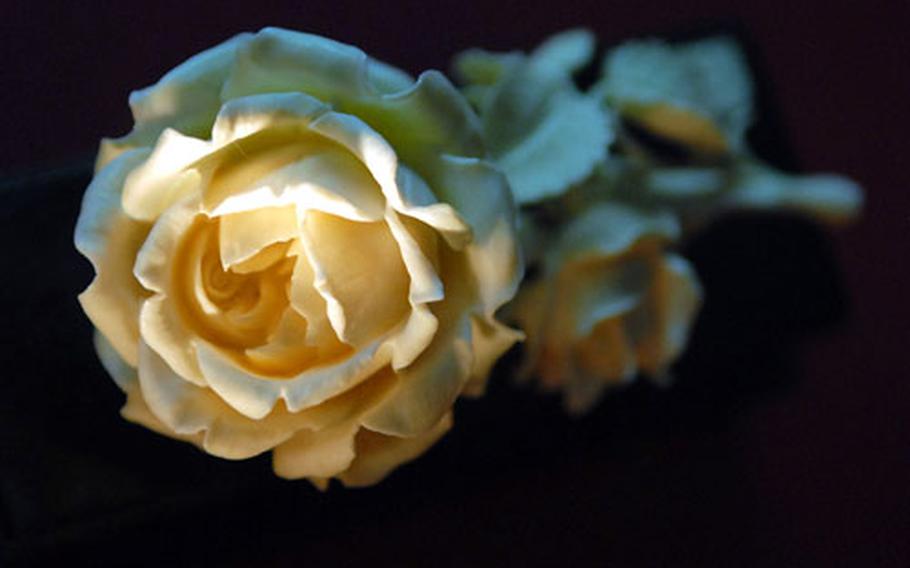
An intricately carved ivory rose from the Erbach ivory carver’s trade school. At the 1873 World’s Fair in Vienna, a prize-winning Erbach rose launched the reputation of the town’s ivory carvers. (Michael Abrams / S&S)
This story is about a museum in Erbach, a town in Germany’s Odenwald region.
But while it plays out there, without two trips to Vienna, Austria, almost 100 years apart, there might not have been a reason for the Deutsches Elfenbeinmuseum, or German Ivory Museum, to exist.
When Count Franz I of Erbach-Erbach went on his six- year grand tour of Europe in 1769, one of his stops was in Vienna, where he discovered the fine art of ivory carving. Later, back in Erbach, where wood-turning on a lathe was a thriving trade, he established a guild charter for ivory carvers.
The ivory carvers of Erbach were skilled in their craft, but it wasn’t until the 1873 World’s Fair in Vienna — where they displayed an award-winning intricately carved ivory rose, called the Erbacher Rose — that their fame and fortune spread.
Hundreds of artisans working in scores of workshops made ivory carving a major industry in Erbach. The craft was, and still is, taught at the local Training College for Wood and Ivory. Even two world wars didn’t do much to harm the craft. However, a 1989 ban on the ivory trade and the unpopularity of items made from a material that resulted from the large-scale massacre of elephants nearly sounded the death knell for the industry.
Luckily, large finds of fossil mammoth tusks and the use of the seed of the ivory nut palm, often called vegetable ivory, saved the carvers. Today, there are about 10 workshops in the area, and the school still produces master carvers.
The museum is about 40 years old, but had a total renovation this year, with new display cases and better lighting, making the 2,000 pieces on exhibit stand out.
The first room after entering the museum has a little about the history of the trade in Erbach, plus displays of carving tools and works by the workshops’ students and interns.
Then the tour of the museum really begins. The first room features European ivory art from every epoch from the Middle Ages to the 20th century. Some fine examples are a mid-18th century sculpture of Cain and Abel; a late-19th century rococo couple; and art deco statuettes from the early 20th century.
Upstairs are rooms dedicated to religious art, including “Sermon on the Mount” carved from a single tusk by Erbach master carver Jan Holschuh, and a fine collection of ivory art from China, Japan and India. Its centerpiece is the man-size “Ship of Luck,” a 19th-century masterpiece featuring the Japanese seven gods of luck on a sailing ship.
Rounding out the upstairs displays are African pieces and Tupilaks, figurines from Greenland made from walrus tusks or whale bone.
Back downstairs, a trio of rooms is dedicated to the works of Erbach carvers, including pieces by Count Franz I. Works by master carvers Otto Glenz, Johann Balthasar Trumpfheller, Holschuh and an Erbach Rose are the highlights. As you exit through the museum’s first room, you pass recent masterworks by the school’s carvers.
All exhibits are labeled in German only, but language won’t keep you from appreciating the fine art of ivory carving.
On the QTDIRECTION: The museum is at the northern end of Erbach im Odenwald, just off highway B45. There are many Erbachs in Germany, so be sure you are headed toward the right one (the postal code is 64711). In town, the museum is well marked by Deutsches Elfenbeinmuseum signs. There is free parking at the museum.
TIMES: Open 10 a.m to 5 p.m. daily but closed Mondays from November through February.
COSTS: Admission is 5.50 euros for adults and 3.50 euros for children. There is a family ticket for 12 euros.
FOOD: There is a cafe/restaurant at the museum, but there are also plenty of good restaurants in the city center.
INFORMATION: A German-only Web site for the museum is on the Erbach city site at www.erbach.de/ kultur/museum/Allgemein.htm. The town’s other museum, the Schlossmuseum in the Counts Palace, is also worth a visit, but it is open only from March to October and the first three weekends of Advent, in conjunction with Erbach’s Christmas market.
— Michael Abrams